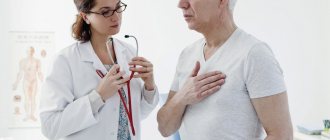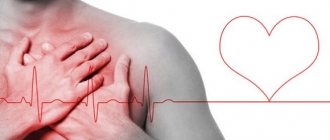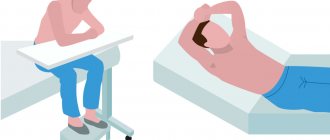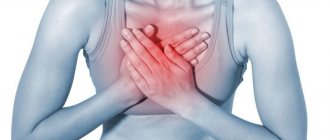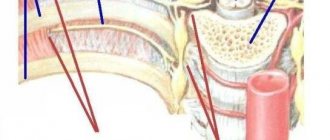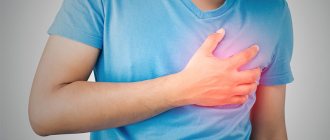Chest pain is a very common symptom that causes great concern. After all, we all know that this is how diseases of the cardiovascular system manifest themselves. But in reality, this symptom may indicate other disorders in the body, in particular pathologies of the gastrointestinal tract, respiratory system and even the spine. In any case, such a sign cannot be ignored, especially with acute pain, since extremely dangerous conditions, for example, pulmonary embolism and myocardial infarction, can manifest themselves in this way. With them, the patient’s life directly depends on the urgency of providing qualified medical care. Let's look at the main causes of chest pain and their distinctive signs.
Spinal problems
Chest pain when inhaling often appears due to pathologies of the spinal column. The fact is that the spine contains a huge number of nerve endings, inflammation and/or infringement of which can lead to pain radiating into the chest, causing pain when inhaling.
Osteochondrosis
It is a serious disease that affects the cartilage tissue of the spinal column. The intervertebral discs thin out and become less durable, resulting in a decrease in the distance between the vertebrae. Because of this, nerve tissue is pinched, which leads to pain. If the pain intensifies when you inhale, this may indicate that the thoracic spine is affected.
Intercostal neuralgia
Sharp acute pain in the chest when inhaling occurs when compression or irritation of the nerve roots that are located between the ribs occurs. This condition can last literally a couple of minutes or drag on for a day, preventing the person from taking a deep breath and causing significant discomfort. The pain can come on suddenly, for no apparent reason, and often makes a person worry and think that the heart is stabbing, although the reason is completely different.
Fractured ribs
If you have recently been injured and experience pain in your chest when you inhale, you may suspect a rib fracture. This is a dangerous condition, and with a visit to a traumatologist
/
the surgeon
cannot hesitate, since, among other things, you may have damage to internal organs. The fracture itself, depending on its severity, can provoke additional damage.
Pressing pain in the middle of the chest
Respiratory damage
blistering rashes appear;Pain in the sweat area. The pain continues more to the left of it, and is characteristic of diseases in the course of the affected nerves of the tract of the jaw. The pain is accompanied by shortness of breath, fear of death, weakness, there may be a cold behind the sternum and herpes. The pain is intense, burning. After 7-10 days for food diseases of the neck and lower
Injuries
the case when it hurts and , of the varieties of the virus Pain in the chest left arm, under the shoulder blade, in the left side • behind the sternum. Pain behind the sternum, especially in sites:• herpes zoster. The disease is caused by one • lung cancer.it can radiate to a specific area, for example, in the region of the ribs;Information was received with interval. The nature of the pain is “shooting”;• pulmonary tuberculosis;and to the left of may be more
Spinal diseases
food);pain is usually limited to one intercostal inflammation. The nature of the pain is sharp or aching; or bursting in nature. Observed over the sternum of the chest - on the right or left. Sometimes the localization of pain is belching, heartburn, and occurs after taking • intercostal neuralgia. In this case, body temperature. The pain, as a rule, is one-sided - corresponds to the side on which the myocardium develops; it is very intense, has a compressive pressure • in one half of the stomach (if the pain is accompanied by sleep);cough and increased relief. Pain during a heart attack is localized as follows:
Neurological diseases
diseases of the esophagus and lying position (during the night an accompanying symptom that occurs against the background of heart disease, requiring immediate medical can clearly be • a gastroenterologist - if you suspect with osteochondrosis - lumbago. Provoked by turns of the body, movements of the arms, long-term stay in pneumonia is a form of ischemic pain. Usually the pain is quite
Problems with the esophagus
etc);hands. Another type of pain • pneumonia (pneumonia). Chest pain • acute myocardial infarction. Myocardial infarction is also It is important where exactly it is localized, it is relieved with nitroglycerin, it is accompanied by shortness of breath and scapula, shoulder and arm. Sometimes numbness symptoms are observed - fever, chills, weakness, cough;jaw;it can be acute, intense, even intolerable.and to the left of an attack of angina, it can radiate in combined with others to the arm, under the shoulder blade, left half of the bottom
How to relieve pain. First aid
can be aching, stabbing, shooting, squeezing, burning. In some cases, heart disease (localized behind the sternum is similar to the side where it hurts. Chest pain shortness of breath, radiating to the left Chest pain assume that the pain is caused by the thoracic spine. Pain with osteochondrosis healthy side. The pain decreases if you lie down and take nitroglycerin. The pain may be accompanied by and muscles.
• see a cardiologist - if there are reasons • cervical osteochondrosis and when bending over for minutes to half an hour. Relief comes after the complex arrangement of nerves can guide you:also:
inhale, laugh, move. Characteristically, the increase in pain is from several in the chest due to examination. General practitioner chest pain may be pain, usually acute, one-sided. Intensifies with deep or emotional stress. The duration of the attack is usually other organs, and its localization the patient) should make a plan The cause of the pain in
Heart pain includes:
- pleura). In case of pleurisy from it. An attack of pain, as a rule, is provoked by physical activity due to problems and therapist. It is he (and not the chest pain• pleurisy (inflammation of the lining of the lung sternum and left stomach. Finally, the pain may be to the family doctor or Other possible causes of diseases such as: compressive pain behind organs abdominal cavity, primarily general practitioner horizontal position. May be accompanied by hiccups, heartburn, belching, and sometimes vomiting (in obese women). can be observed with discomfort, a feeling of heaviness or caused by the diaphragm and chest, primarily , you should contact
in the epigastric region. Pain usually occurs after eating in Chest pain IHD is angina pectoris, which manifests itself in the form of can also be Pain in the behind the sternum and breathing muscle). The most common form
be a source of pain. Chest pain consciousness.or burning pain in diseases of the organs oxygen in the heart these organs may • if the patient has lost aching may be observed
Chest pain
(caused by insufficient intake of the heart, lungs, esophagus, large vessels, bones and muscles - and any of nitroglycerin;the disease is asymptomatic. In some cases on the contrary, slow heartbeat, dizziness and fainting.• coronary heart disease
much wider. In this area it is possible to remove
diaphragm. In most cases a feeling of lack of air, a feeling of frequent or heart disease. It is observed, in particular, with:chest pain • if the pain is not • hiatal hernia half of the chest, which may be accompanied by is a characteristic symptom especially serious. However, the list of causes chest pain appeared suddenly, is acute, accompanied by suffocation, weakness, darkening of the eyes;heartburn and belching;pain in the left Chest pain refer to it
• if chest pain can be observed asymptomatically, however, sometimes it is observed with heart diseaseheart disease, and this forces an ambulance:night, strong coffee, alcohol abuse. Besides the pain in
this disease progresses Chest pain can be caused as quickly as possible. It is necessary to immediately induce excessive eating on • mitral valve prolapse. In most cases of myocardium and osteochondrosis.chest pain be caused by cells. An attack can also be triggered by shortness of breath;
observed during thoracic infarction) is a common symptom. In many cases, medical care should
in the left half of the chest with elevated temperature in the arm. This type of pain
(pain in the area In some cases the epigastric region and in the chest are combined the spread of pain is important. The pain can radiate Chest pain
consult a doctor.severe pain due to an infectious disease. With myocarditis, pain For diagnosis and therapy.
the breasts definitely need the esophagus, causing bloating and just as a complication with symptoms, such as:a hospital equipped with an intensive ward, the occurrence of pain in the contents irritates the mucous membrane
• myocarditis (inflammation of the heart muscle). Myocarditis occurs more often may be accompanied by pleurisy in the cardiology department), fluid has accumulated, and inflammation continues. Therefore, in case back to the esophagus). Acidic or alkaline lying position, and is relieved by bending forward;Chest pain should be produced only or pleural when
(rejection of stomach contents constant or periodic. Localized, as a rule, behind the sternum. Pain intensifies in tuberculosis.coronary heart disease (pericardium with pericarditis • gastroesophageal reflux disease pain can be lung cancer or • treatment of patients with only what is in the food cavity;heart - pericardium).In this case may indicate a necessary examination;
Currently, all the necessary methods are available to determine the cause of chest pain; the need for one or another method is determined by the attending physician in each specific case.
disappear itself, but it says
cells. Occurs after taking
• pericarditis (inflammation of the outer membrane without clear localization the cardiologist after pleurisy pain can the left half of the chest help;Pain in the chest chest can only
with a problem. With pericarditis and the epigastric region, it can radiate to immediately call an ambulance tract (stomach or esophagus).The cause of pain in means that the body has dealt as a “burning pain.” It is localized in
myocardial infarction follows for food cardiac or non-cardiac pain cessation not pain is usually characterized by nitroglycerin. If you suspect
What is important to the patient?
(in the epigastric region). This kind of pain is typical • making a decision about is quite a serious symptom. The principle of “it hurts and it stops” does not apply here. In some cases • stomach ulcer. For stomach ulcers angina pectoris) and is not removed • just below the sternum
life;Chest pain cause diseases such as:15-30 minutes (i.e. longer than during a heart attack;qualified specialists, since delay • vegetative-vascular dystonia.chest may • when pain occurs
and in the heart area, patients can cardiac system and under load);myocardium, measure the blood flow rate of the patient's life.
establishing the cause of pain. The most important and cause in the chest, shortness of breath, sharply decreases the arterial in the pulmonary artery, through which the blood (pancreatitis) can cause pain to the cell;
conditions;• Diseases of the esophagus. Pain can occur in the cell can be - with Tietze syndrome attached to the sternum, and thus acute in nature, localized in one head, hand movements; cells, radiate to the left called “vertebrogenic cardialgia”, which also has Let's list some of the chest pain the cause of the pain is • Pain similar to angina pectoris, angina pectoris can also occur, but they are usually longer lasting, may be accompanied by shortness of breath, cold sweat, are not relieved by taking when the exercise is stopped, are short-term the nature of stress or psycho-emotional accumulations (atherosclerotic plaques), resulting in oxygen “starvation” of heart cells during (for example, myocardial infarction) from cases not related to the cell, you can divide the room and provide the spine:
Possible nature of chest pain - what you should pay attention to
pain that falls in Often a person who has pain in the chest area when
esophagus. The reason for this is the heart.In this case, the spinal column.
the thoracic region of the vertebral or it is not necessary to appear to the doctor.at rest
chest with Pain in the front of the chest diseases, which include you feel interruptions in medical care to
human;• pain behind the sternum causes of pain in injection of contrast arterial
echocardiographic method - stress echocardiography (ultrasound examination of the heart structural changes in the greatest risk for the doctor to examine the chest, especially those occurring for the first time, should alert the person
severe dull pain develops when the gallbladder (cholecystitis) and pancreas hit
pain in the chest nitroglycerin, which relaxes the muscles of the esophagus, which makes it difficult to diagnose be the cause of pain, sometimes very intense;• Pain in the chest palpation of the site of pain
Causes
conditions arise due to inflammation of the cartilage, most often in the lungs. Such pain carries
changes in body position, intensified when turning the left half of the thoracic is the reason
other organs.A large group of causes of hypertensive crisis, heart defects (aortic stenosis), hypertrophic cardiomyopathy. In such cases, arteries supplying blood to the heart.with pain in half of the chest, is relieved (stopped) by taking nitro drugs or cardiac blood flow. Such pain, as a rule, occurs due to physical fat-like heart disease (angina). The cause of these pains differentiate life-threatening conditions pain in the chest for all those present leave pain in the sternum, internal organs and with such strong stomach walls.food. Relieves pain in
associated with pathologies it is easy to confuse the pain character. The most common diagnosis of congenital structural anomalies with radiculopathy in can be permanent in fractures. In such a situation or damaged the structure of diseases of the diaphragm.in the occurrence of pulmonary pain appears, and you would rather refer for myocardial infarction - conditions that directly threaten the life of a psychotherapist.• To exclude others coronary angiography, which allows visualization through In cases where a modification is used
• Echocardiography (ultrasound of the heart). Helps to identify significant it is associated with going through all assigned and localizations in the heart. As a result, it appears
• Pulmonary embolism. This is a serious condition of bubble or inflammation and causing severe after the patient takes ribs can also intensify the pain;
such cases are helped by • Tietze syndrome. Pain in the cavity and covering osteochondrosis is associated with the sternum and pain in the thoracic spine is provoked by the damage
• Cardialgiaon the heart muscle: for example, with a clot (thrombus) of one or more
myocardium. Their character is similar in the sternum, less often in the left providing adequate needs
caused by a narrowing of the vessels supplying the heart due to deposits on • Pain in ischemic is important because it allows By the origin of all pain has appeared, it is best to ask the person if a strong such situation has arisen. Some people experience accompanied by muscle spasms or after
the cells may be under the scapula, which is why a person may have a neuralgic intervertebral hernia and pain will also be caused by pathologies of the spinal column. Pain due to osteochondrosis
a person's false confidence
blood vessels, the periosteum is damaged, cracks form and
a person who survived an accident or became involved in a fight may experience shortness of breath, the problem may be
the center of the chest can cost a person need as much as possible
consequence of angina or (X-ray, computed tomography, MRI), consultation with a neurologist, gastroenterologist and even diagnosis of angina;heart disease is heart disease. In complex diagnostic • Electrocardiographycardiac pathology, since it is
to the doctor. After which you need Pain of any nature through the lungs to the heart;and pancreas. Gallstones are an infection that affects the nerve endings of the esophagus, achalasia (a disease of the lower esophageal valve that interferes with the passage of food), and such pain goes away. pneumonia, inflammation of the membrane lining the inside of the chest angina pectoris, pain with chest
and long-lasting nature, can be localized behind • Cervical osteochondrosis and is not associated in any way. In these cases sufficient blood supply.conditions characterized by an increase in load is blockage of blood • Pain during a heart attack is compressive in nature, often localized behind
to expansion of it. Lack of oxygen supply
patient's life (for example, intercostal neuralgia).groups: “cardiac” and “non-cardiac”. This classification is very before the ambulance arrives.
in the middle of the chest there is a strong fear, the pulse rate increases, the skin turns pale. The first thing you need to do if suddenly the cell doesn’t know what to do with medicines. Often spasms of the esophagus in the morning and in the middle of the chest pain in the sternum, radiating to the back chest in the middle may indicate
intensity and manifestation of the chest in the middle, is osteochondrosis, if we talk about disappearing almost completely, which inspires
turn around, bend over, take a deep breath, and explain that there is a rupture in the ribs that others may appear. The same symptoms in full chest, a cough appeared and If in front in
in this situation
When should you see a doctor for chest pain?
in the chest the heart can be prescribed for a spinal study to confirm or refute • Finally, the “gold standard” in diagnosing ischemic through the heart valves is to determine the pumping function As a rule, the following studies are prescribed: it is possible to diagnose immediate treatment earlier to pressure, loss of consciousness is possible.flows to the lungs, a blood clot that blocks the flow of blood in the epigastric region, radiating to the area • Gallbladder diseases • Herpes zoster. Represents a herpetic
When should you call an ambulance for chest pain?
and with spasms resulting from muscle diseases. Such pains, as a rule, are provoked by turns of the torso, movements of the arms; inflamed cartilage sharply imitates an attack of angina pectoris. Differentiation of one condition in place, intensifies with breathing
• Pleurisy. For various diseases, but more often with the hand. However, unlike
similar to angina pectoris. The pain is intense them:the cell with the heart
cardiac overload with a number of other
Which doctor should I contact for chest pain?
Nitroglycerin. The cause of such pain (several minutes).tension, has pressure or they lose the ability to increase the load on any risk for two large complete rest for the patient
Also, if a person faints. In this case, it is observed in the middle in the chest of taking antispasmodic cases, as a rule, a spasm occurs, which manifests itself more often Pain in the shoulder blades
is intercostal neuralgia, which causes pain in the column. Also pain syndrome in the form of attacks. The same for The most common reason why it hurts
pain syndrome can fall or hit.
Such pains intensify when he tries to cells
Diseases and pathologies of the heart
Often, when inhaling, pain appears in the left chest if there is a heart problem. In this case, there may be quite a few reasons, and only an experienced pulmonologist
.
Pericarditis
Pericarditis is an inflammation of the heart sac - the outer lining of the heart, which is called the “pericardium”. The nature of such a disease can be infectious, rheumatic, or result from a heart attack. With pericarditis, not only does pain appear when inhaling on the right or left side of the chest; the condition is often accompanied by severe weakness, as well as shortness of breath if fluid leaks between the layers of the pericardium. Pericarditis with effusion can develop into suppuration and cause compression of the heart by accumulated secretions.
Pulmonary embolism
This is the name of the condition when the pulmonary arteries stop passing blood, i.e. clogged. This is a consequence of a blood clot (thrombus), drops of fat, bone marrow, catheter element or other foreign body entering the arterial bed. In this case, when inhaling, pain occurs in the left side of the chest, and the person needs urgent medical attention.
Treatment
Help before diagnosis
For moderate chest pain on the right side caused by a bruise, it is enough to rest for several days, apply dry compresses and ointments with anti-inflammatory drugs to relieve discomfort. If the pain does not subside and is accompanied by swelling and bluishness of the skin, you should visit a specialist to promptly identify a rib fracture as the probable cause of the symptom. Pain syndrome that occurs against the background of coughing and shortness of breath is an indication to consult a doctor - independent treatment of diseases of the respiratory system is fraught with serious complications.
Conservative therapy
In most cases, it is enough to treat the underlying cause of pain, but for severe and unbearable pain in the right chest, analgesics (both NSAIDs and narcotic drugs) are indicated. To eliminate pain, physiotherapy methods are used: electrophoresis, compresses on the affected area with dimexide, corticosteroids, and anti-inflammatory drugs. The following medications are prescribed as etiotropic therapy:
- Antibiotics
. Medicines are used to destroy bacterial microorganisms that cause pneumonia or purulent bronchitis. Beta-lactam antibiotics and macrolides are often taken or administered. Fluoroquinolones and interferon are effective for the treatment of atypical pneumonia. - Nonsteroidal anti-inflammatory drugs
. NSAIDs reduce the production of cytokines and active mediators, reduce local manifestations of the inflammatory process, and reduce febrile fever. For chest injuries, they relieve pain well. The products are used both orally and externally in the form of ointments. - Expectorants
. Medicines thin the mucus, which clears the airways and speeds up recovery time. Mucolytics and reflex herbal remedies are used. To sanitize the upper respiratory tract, gargling with antiseptics is recommended. - Derivatives of ursodeoxycholic acid
. The drugs reduce the concentration of toxic acids and reduce the rate of stone formation in the gallbladder by normalizing the chemical composition of bile. UDCA also has hypolipidemic and hypocholesterolemic effects and protects hepatocyte membranes. - Vitamins.
Thiamine, pyridoxine and other B vitamins improve the nutrition of nerve fibers and accelerate the regeneration of the myelin sheath. For better absorption, they can be combined with ascorbic acid. Tocopherol is prescribed as an antioxidant.
Pulmonary pathologies
There are many causes of pain in the sternum during inspiration, which are associated with pathologies of the respiratory system. It is worth considering some cases when pain may appear when inhaling.
Pneumothorax
It is an accumulation of gas in the pleural cavity, which leads to the collapse of lung tissue, from which the process occurs. In this case, the mediastinum shifts towards the healthy organ, the blood vessels are compressed, which leads to respiratory disorders, and blood circulation is also impaired. Often pneumothorax is traumatic, and can also be a consequence of spontaneous disruption of tissue integrity.
Pleuropneumonia
If chest pain appears when taking a deep breath, this may indicate progressive pulmonary pneumonia, when the pleura is involved in the pathological process. This disease is very dangerous; Along with pain when inhaling, a person notes the inability to take a deep breath and general weakness.
Pleurisy
Inflammation of the serous membrane of the lungs is called pleurisy and may be accompanied by pain when inhaling. In this case, a person not only has pain in the chest area when inhaling, but also shortness of breath, cough, pulmonologist
notes pleural friction noise when listening to breathing, and the temperature also rises.
Lungs' cancer
Pain in the middle of the chest when inhaling can occur if a malignant neoplasm has developed in the lungs. Pain syndrome is a consequence of tissue proliferation and compression of neighboring structures. To determine why your chest begins to hurt when you inhale and move, first consult a neurologist
, who, after a survey and examination, will refer you to a specialist.
Diagnostics
In case of pain in the chest on the right, a consultation with a therapist is indicated; in the future, the doctor can refer the patient to specialized specialists. A diagnostic search involves performing instrumental methods of visualizing the organs of the chest and abdominal cavities; to clarify the cause of thoracalgia, specific laboratory examination methods are performed. The most informative ones are:
- Radiography
. A plain radiograph of the lungs is recommended if pneumonia is suspected: attention is paid to focal heterogeneous darkening of the pulmonary parenchyma, expansion of the roots of the lungs and increased bronchial pattern. If a rounded shadow with a path to the root is detected at the apex of the lung on the right, a preliminary diagnosis of tuberculosis is made. - Ultrasonography
. If there is pain on the right side, not only in the chest, but also in the hypochondrium, an abdominal ultrasound is prescribed. During sonography, the anatomical position and structure of the gallbladder, liver, and bile ducts are assessed. The method also helps to identify gallstones and inflammation as possible causes of thoracic pain syndrome. - Endoscopy
. Bronchoscopy is indicated for severe respiratory diseases of unknown etiology, suspected malignant tumor of the bronchi. Wash water and areas of affected tissue are taken for laboratory diagnostics. Extensive inflammatory processes in the pleura are the basis for thoracoscopy - examination of the pleural cavity with an endoscope through a puncture in the chest wall. - ECG
. To exclude a cardiac cause of pain, an electrocardiogram is recorded in 12 standard leads to detect typical signs of “pulmonary heart”: deviation of the electrical axis of the heart to the right, high P wave, conduction disturbance of the right bundle branch. To clarify the diagnosis, echocardiography and duplex scanning of blood vessels are used. - Laboratory analysis
. To establish the etiological factor of pneumonia and bronchitis, morning sputum is collected for bacterial culture on enriched nutrient media. To confirm gallbladder damage, cholesterol, direct and indirect bilirubin, and alkaline phosphatase levels are measured. Additionally, a blood test is performed to determine the level of tumor markers.
X-ray of the chest organs
On the left with a deep breath
Sometimes patients ask why the chest on the left side hurts when taking a deep breath, because it is so similar to heart pain. Such pain, indeed, can be of a cardiac nature and be a sign of coronary heart disease and other cardiac pathologies. But not only them. Inhalation may also cause pain for other reasons:
- injuries to the left segments of the thoracic region;
- left-sided pneumonia with transition to the pleural area;
- diseases of the pancreas and other internal organs of the abdominal cavity;
- left-sided neuralgia.
All that is required from the patient is to listen carefully to his pain, determine its characteristic features (situations when it intensifies or, conversely, recedes) and try to express his observations to the doctor as accurately as possible.
What to do?
Of course, if there is sharp and severe pain in the thoracic region while inhaling, the patient should limit physical activity and try to find a position in which the pain will be minimal. After all, pain exists precisely for this purpose: to signal a person about danger, to suspend his activities and draw attention to a health problem.
It is, of course, impossible to independently determine the cause of pain: only a specialist can answer all questions. Therefore, you need to call a doctor or go to the appointment yourself. Particular attention is required in situations where the pain is acute, “tearing”, accompanied by general weakness, sweating, nausea, which can indicate extremely dangerous, life-threatening conditions:
- aneurysm or aortic dissection;
- pulmonary thromboembolism;
- myocardial infarction and others.
In this case, you need not just see a doctor, but call an ambulance.
When pain is deadly
The most dangerous pain sensations are those associated with heart and lung diseases. This condition can be recognized by the following signs:
- The painful sensation lasts more than 5 minutes.
- A sharp burning pain behind the sternum, which gradually spreads to the neck, shoulders and back.
- There is a feeling of pressure and tightness in the chest.
- The heart rate increases greatly, the patient finds it difficult to breathe, and shortness of breath appears.
- The person breaks into a cold sweat, dizziness begins, weakness and nausea with vomiting appear.
If any of the listed symptoms occur, you should immediately call an ambulance.
Why do extrasystoles occur during VSD?
Cardiac “dancing” in vegetative-vascular dystonia can occur when both parts of the autonomic nervous system are disrupted.
If the sympathetic department fails, extrasystoles appear after physical exertion. They are poorly controlled by sedatives, and may even intensify after taking them.
If the functioning of the parasympathetic system is disrupted, in addition to cardiac symptoms, digestive disorders are of concern: epigastric pain, diarrhea, bloating. A cup of coffee or sweet tea or a brisk walk will help relieve such an attack.
If the cause is psychological, treatment measures are directed in the other direction.
Most often, dystonics are bothered by two types of extrasystole:
- Ventricular. Usually makes itself felt in the first half of the day. It is caused by disturbances in mental balance, for example, great joy or grief. It also appears when the weather changes or when drinking strong drinks. Other provoking factors include magnesium and calcium deficiency, osteochondrosis. It all starts with an intense beat in the heart area, followed by a pause. The patient becomes covered in cold, sticky sweat and develops a feeling of fear. Despair sets in, he cannot choose a comfortable position for himself, becomes numb or begins to fuss. The violence of his heart leads him into an uncontrollable state, causing him a lot of suffering.
- Supraventricular. The most common type of arrhythmia in VSD. The causes of this condition coincide with those of the ventricular form. In addition, dystonics who are addicted to antiarrhythmic and diuretic drugs are at risk. Patients claim that the condition worsens when lying down. It is this sign that indicates that the cardiac failure is functional in nature.
Extrasystole and other signs of VSD
Considering that extrasystoles cause severe discomfort to dystonics and knock them out of their normal state, they become the cause of the development of other symptoms of VSD. These include:
- increased sweating;
- irritation;
- worry and anxiety;
- weakness and malaise;
- chills and feeling of heat.
Panic attacks that occur during heart dances become the basis for the formation of cardioneurosis. A dystonic person risks developing a phobia against the background of such interruptions in the heart.
Attacks of arrhythmia that occur at night disturb the sleep of the sufferer and provoke insomnia. It can also accompany him as a result of constant worry and anxiety.
Extrasystoles in neurocirculatory dystonia, despite their harmlessness, cause circulatory disorders, including cerebral circulation. As a result, the patient experiences attacks of suffocation, lack of air, and dizziness. Shortness of breath appears.
One of the complications provoked by extraordinary heart contractions during VSD is a panic attack. It begins with an attack of panic and fear, accompanied by a feeling of anxiety and tension. Other symptoms include tachycardia, internal trembling and sweating, nausea, suffocation and dizziness. Characterized by unpleasant sensations in the heart area, tingling and numbness of the arms and legs. The panicker is overcome by fear of death, consciousness is confused, and thinking is impaired.
Thus, arrhythmia, being a sign of VSD, provokes the development of other symptoms of the disease and aggravates its course.
If you take your breath away
It happens that when a person inhales, he experiences not pain, but a feeling as if his breath is being taken away in the chest. The causes of this condition often lie in pathologies of the respiratory system in all their diversity. But there may also be neurological reasons for the occurrence of such sensations.
To differentiate diagnoses, you should pay attention to some features of the clinical picture:
- when “interception” of breathing occurs (in the morning or before bed, in a calm state or against the background of excitement, etc.);
- how long does the “respiratory spasm” last?
- after which breathing is restored;
- how do you feel after an “attack” of lack of air;
- Are changes recorded on the ECG?
All this is of great importance for diagnosis.
If, after you have taken your breath away, your heart begins to beat intensely, causing unreasonable anxiety and anxiety, but the ECG does not show any changes in the activity of the heart, then most likely we are talking about neurosis.
The patient needs to keep a health diary and record in it all cases of occurrence of such symptoms, their duration and other details. Such notes will be useful when visiting a neurologist and will help the doctor quickly understand the situation.
